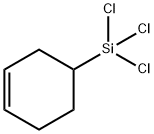Cyclohexenyl trichlorosilane is a colorlessfuming liquid that smells like hydrogen chloride. Molecularweight=215.59; Boiling point=94℃; Flash point=99℃.Hazard Identification (based on NFPA-704 M RatingSystem): Health 2, Flammability 2, Reactivity 0. Reactswith water.
Cyclohexenyl trichlorosilane is a colorless
fuming liquid. Odor like hydrogen chloride.
A colorless liquid with a pungent odor. Flash point of 199°F. Corrosive to metals and tissue. Used to make various silicon containing compounds.
Reacts violently with water, steam, moist air, alcohols, acetone, light metals with generation of heat and combustible (H2) and corrosive (HCl) gases. on contact with air 3-CYCLOHEXENYLTRICHLOROSILANE gives off HCl gas. REF [Handling Chemicals Safely, 1980 p. 924].
Chlorosilanes, such as 3-CYCLOHEXENYLTRICHLOROSILANE, are compounds in which silicon is bonded to from one to four chlorine atoms with other bonds to hydrogen and/or alkyl groups. Chlorosilanes react with water, moist air, or steam to produce heat and toxic, corrosive fumes of hydrogen chloride. They may also produce flammable gaseous H2. They can serve as chlorination agents. Chlorosilanes react vigorously with both organic and inorganic acids and with bases to generate toxic or flammable gases. Special Hazards of Combustion Products: Irritating, toxic hydrogen chloride and phosgene may be generated in a fire.
Inhalation causes irritation of mucous membrane. Contact with eyes or skin causes severe burns. Ingestion causes severe burns of mouth and stomach.
Moderately toxic by
ingestion and skin contact. An eye and
severe skin irritant. A corrosive material. It
fumes in moist air, releasing HCl.
Combustible when exposed to heat or
flame. When heated to decomposition itemits toxic fumes of Cl-. See also
CHLOROSILANES.
This material is used to make silicone
polymers.
If this chemical gets into the eyes, remove anycontact lenses at once and irrigate immediately for at least15 min, occasionally lifting upper and lower lids. Seek medical attention immediately. If this chemical contacts theskin, remove contaminated clothing and wash immediatelywith soap and water. Seek medical attention immediately. Ifthis chemical has been inhaled, remove from exposure,begin rescue breathing (using universal precautions, including resuscitation mask) if breathing has stopped and CPR ifheart action has stopped. Transfer promptly to a medicalfacility. When this chemical has been swallowed, get medical attention. If victim is conscious, administer water ormilk. Do not induce vomiting. Medical observation isrecommended for 24-48 h after breathing overexposure, aspulmonary edema may be delayed. As first aid for pulmonary edema, a doctor or authorized paramedic may consideradministering a corticosteroid spray.
Color Code—White: Corrosive or Contact Hazard;Store separately in a corrosion-resistant location. Prior toworking with Cyclohexenyl trichlorosilane you should betrained on its proper handling and storage. Store in tightlyclosed containers in a cool, well-ventilated area away fromwater, steam, and moisture because toxic and corrosive chloride gases, including hydrogen chloride, can be produced. Sources of ignition, such as smoking and openflames, are prohibited where cyclohexenyl trichlorosilane isused, handled, or stored in a manner that could create apotential fire or explosion hazard.
UN1762 Cyclohexenyl trichlorosilane, Hazard
class: 8; Labels: 8-Corrosive material.
Incompatible with oxidizers (chlorates,
nitrates, peroxides, permanganates, perchlorates, chlorine,
bromine, fluorine, etc.); contact may cause fires or explo-
sions. Keep away from alkaline materials, strong bases,
strong acids, oxoacids, epoxides. Chlorosilanes react vigor-
ously with bases and both organic and inorganic acids gen-
erating toxic and/or flammable gases. Chlorosilanes react
with water, moist air, or steam releasing heat and toxic,
corrosive fumes of hydrogen chloride. The reaction may
also release flammable hydrogen fumes. Attacks metals in
the presence of moisture. Some chlorosilanes are pyro-
phoric; self-ignite in air. Contact with ammonia can cause
a self-igniting compound.

